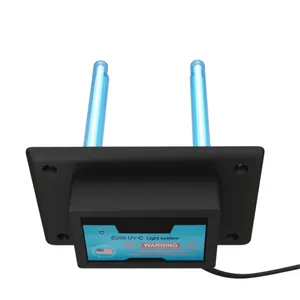
JNUO Portable Japanese Difussure Hepa Filter Cat It Room Uv Hepa Air Purifiers Dog Smell With Solar For Bedroom Home



G200 Dual Air Purifier Whole House Uvc Light In Duct For Air Conditioning Ductir Cleanser For HVAC/AC Ductwork




















UV air purifier devices use shortwave UV-C radiation to eliminate airborne diseases and germs like mould, bacteria, and viruses. Like all other air purifiers, the UV light air purifier aims to minimize and remove indoor air contaminants. On the other hand, UV technology differs from other air purifiers in that it inactivates pollutants rather than simply eliminating them, making the air around them cleaner, safer, and better for everyone.
As air flows through the devices, the humidifier passes through UV-C technology, which uses germicidal UV radiation to destroy airborne pollutants directly. The primary safety risk is that UV light may produce ozone during this process (these fears stem from the early UV mercury lamps used in the mid-twentieth century). Humans are at risk from direct exposure to UV-C light. However, UV-C light is contained inside leading personal devices such as Respiray, ensuring that humans are not exposed to it. Today, respected UV air purifiers include UV-C light in devices that create no ozone, making them safer.
The current UV air purifier consists of two device types. Standalone or freestanding devices and personal and wearable devices. A stand-alone UV air purifier is a piece of equipment for controlling air quality. It utilizes UV-C light to eliminate harmful bacteria, viruses, and other pathogens from the air in a room, making it safe to breathe. UV air purifier for home or workplaces are often small and compact. Still, some models are more significant than others, but depending on the model, it may take longer to cleanse the air in the room. Some include mercury lamps and do not necessarily employ more efficient UV-C LEDs.
A personal UV air purifier provides speedier protection once turned on. It provides instant protection and eliminates the need to wait for a room to be purified. Furthermore, the wearer can change locations without purifying a new room or transferring a single pure air purifier. Wearable UV air purifiers won't get dirty or clogged without filters, so there's no need to change the filters. Wearable UV air purifiers are part of a hybrid system that kills hazardous airborne viruses, germs, and pathogens without a mask. They are also more environmentally friendly than masks because they can be reused.
One of the primary benefits of air purifier with UV light is that it improves indoor air quality. UV radiation from an air purifier damages pathogen DNA and disrupts its operation. Pathogens cannot replicate or spread diseases after being exposed to UV radiation. UV light-based air purifiers are also efficient against bacteria, viruses, and germs that cause colds, TB, chickenpox, mumps, measles, and flu.
Businesses that seek to increase client trust could benefit from an air purifier for large room with UV light. Customers will be more likely to visit or transact if they have a unit around their stores. UV-light air purifiers eradicate pathogens and allergens such as pet dander, moulds, grime, and dust that standard cleaning routines cannot remove. Allergy flare-ups can be challengin to deal with because they create a series of symptoms, including eye discomfort, runny nose, sneezing, and wheezing.